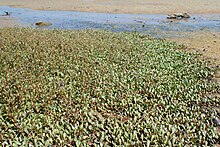Bunge (genus)
| Bunge | ||||||||||||
|---|---|---|---|---|---|---|---|---|---|---|---|---|

Salt bunge ( Samolus valerandi ) |
||||||||||||
| Systematics | ||||||||||||
|
||||||||||||
| Scientific name | ||||||||||||
| Samolus | ||||||||||||
| L. |
The plant genus Bunge ( Samolus ) belongs (since APG II) to the subfamily Theophrastoideae within the primrose family (Primulaceae). The 10 to 15 species worldwide thrive in all climatic zones, with a focus on temperate climates on all continents. Most species are found in the maritime climate of the southern hemisphere .
description




These one- to multi-year , herbaceous plants reach all only maximum plant height of 50 centimeters. The stem is upright and can become slightly woody at the base. All species have stalked, simple leaves ; they are alternate and can also form a native rosette in some species. Stipules are absent.
The terminal inflorescences are grapes or umbrella grapes (Corymbus). The radial symmetrical , hermaphrodite flowers are five-fold. The five sepals are fused tube-like at the base and also fused with the ovary. The five petals are fused bell-shaped. The five stamens have only short stamens. In contrast to other species of the subfamily Theophrastoideae , the ovary in Samolus is semi-subordinate. They form round, five-lobed capsule fruits .
Systematics and distribution
The genus Samolus was established by Carl von Linné . The genus name Samolus is derived from an ancient Celtic name for Samolus valerandi used by the Druids . The type species is Samolus valerandi L. Samolus is the only genus of the Samoleae and belongs (since APG II) to the subfamily Theophrastoideae within the primrose family (Primulaceae), earlier it was an independent family Samolaceae or Theophrastaceae.
The 10 to 15 species worldwide thrive in all climatic zones, with a focus on temperate climates on all continents. Most species are found in the maritime climate of the southern hemisphere . In Central Europe and China only a way that falsely also comes brooklime -called salt-Bunge ( Samolus valerandi ) ago.
There are 10 to 15 types:
- Salt bunge ( Samolus valerandi L. ): It is also used in aquaristics . This most widespread species has a very wide range in Eurasia , Africa , Australia and the New World .
- Samolus cinerascens Pax & R.Knuth : It occurs in Mexico .
- Samolus dichondrifolius Channell : It occurs in Mexico.
- Samolus ebracteatus Kunth : It is distributed from the USA to Mexico and on the Caribbean islands .
- Samolus junceus R.Br. : It occurs in Australia .
- Samolus parviflorus Raf. : It iswidespreadfrom North to Central America and occurs on the Caribbean islands , in Bolivia and in Japan .
- Samolus porosus Thunb. : It occurs in South Africa .
- Samolus repens Pers. : It occurs in Australia and New Zealand .
- Samolus spathulatus Duby : It occurs in South America .
- Samolus subnudicaulis A.St.-Hil. ex Compt. : It occurs in Brazil .
- Samolus vagans Greene : It occurs only in the US state Arizona and the Mexican state Durango .
swell
- Qiming Hu & Sylvia Kelso: Primulaceae. : Samolus , p. 188 - the same text online as the printed work , In: Wu Zheng-yi, Peter H. Raven (Ed.): Flora of China. Volume 15: Myrsinaceae through Loganiaceae , Science Press and Missouri Botanical Garden Press, Beijing and St. Louis 1996, ISBN 0-915279-37-1 .
- Anita F. Cholewa: Samolus. , P. 254: - the same text online as the printed work , In: Flora of North America Editorial Committee (ed.): Flora of North America North of Mexico. Volume 8: Paeoniaceae to Ericaceae , Oxford University Press, New York and Oxford 2009, ISBN 978-0-19-534026-6 .
Individual evidence
- ↑ a b Bunge from the Red List Flora Germany according to the standard list of German plant names from 1998.
- ↑ a b c d e f g Qiming Hu & Sylvia Kelso: Primulaceae. : Samolus , p. 188 - the same text online as the printed work , In: Wu Zheng-yi, Peter H. Raven (Ed.): Flora of China. Volume 15: Myrsinaceae through Loganiaceae , Science Press and Missouri Botanical Garden Press, Beijing and St. Louis 1996, ISBN 0-915279-37-1 .
- ↑ a b c d Samolus on the APG website.
- ↑ a b c d e Anita F. Cholewa: Samolus. , P. 254: - the same text online as the printed work , In: Flora of North America Editorial Committee (ed.): Flora of North America North of Mexico. Volume 8: Paeoniaceae to Ericaceae , Oxford University Press, New York and Oxford 2009, ISBN 978-0-19-534026-6 .
- ↑ Samolus at Tropicos.org. Missouri Botanical Garden, St. Louis, accessed August 26, 2015.
- ↑ Samolus in the Germplasm Resources Information Network (GRIN), USDA , ARS , National Genetic Resources Program. National Germplasm Resources Laboratory, Beltsville, Maryland. Retrieved August 26, 2015.
- ^ Wim Crusio : Het geslacht Samolus L. In: Communications of the Dutch Waterplant Society . tape 2 , 1982, p. 13-25 (Dutch).
- ^ Wim Crusio: Notes on the genus Samolus L. (Primulaceae) . In: Communications of the Dutch Waterplant Society . tape 6 , 1984, pp. 13-16 (English, researchgate.net ).
Web links
- Samolus at Tropicos.org. In: IPCN Chromosome Reports . Missouri Botanical Garden, St. Louis
- Samolus at Tropicos.org. In: Peru Checklist . Missouri Botanical Garden, St. Louis
- Samolus at Tropicos.org. In: Bolivia Checklist . Missouri Botanical Garden, St. Louis
- Samolus at Tropicos.org. In: Catalog of the Vascular Plants of Ecuador . Missouri Botanical Garden, St. Louis
- Samolus at Tropicos.org. In: Catalog of the Vascular Plants of Madagascar . Missouri Botanical Garden, St. Louis
- Samolus at Tropicos.org. In: Flora Mesoamericana . Missouri Botanical Garden, St. Louis
- Samolus at Tropicos.org. In: Flora of Pakistan . Missouri Botanical Garden, St. Louis
